如何用SplitViewController控件
【IT168技术】在苹果公司推出iPad以后,基于iPad的大画面,同时提供了在iPhone不支持的多个新的ViewController,其中一个就是SplitViewController。
但是从苹果公司提供资料以及网上的各种信息来看,似乎无法在TabBar中使用SplitViewController,在IB中也只能设置Tab为ViewController或者TableViewController。
网上有很多人讨论这个课题,本人也在开发一个软件时希望某一个Tab中能使用SplitViewController,经过多方研究,终于找到在Tab中实现SplitViewController的方法,在网上介绍后已被国外的开发者采用,请看一个德国开发者的作品http://itunes.apple.com/de/app/jugendsprache-worterbuch-der/id399206394?mt=8,现将此法介绍给大家共享。
根据使用者的爱好和编程熟练度可以分成两种做法,其一是以IB为主编程为辅的方法,其二是完全编程方法,下面将介绍前一种方法。
第一步:使用xCode的SplitView模版生成一个新项目并编译保存。
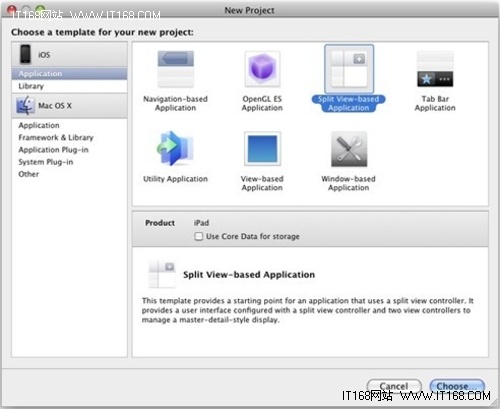
第二步:再用xCode的TabBar模版作为你的新项目并编译保存,假设项目名为SplitInTabBarAppDelegate
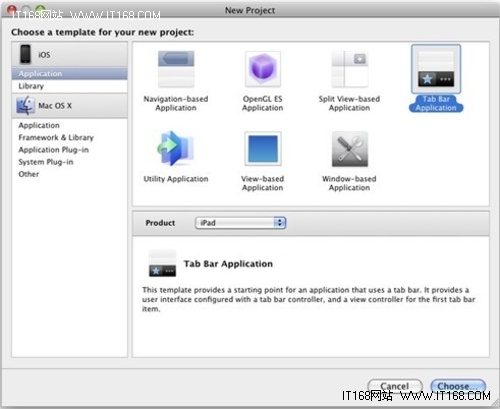
第三步:在第二步的项目中加一个新Tab

第四步:把第一步生成的项目中的RootViewController.*, DetailViewController.*等文件复制到第二步的项目中
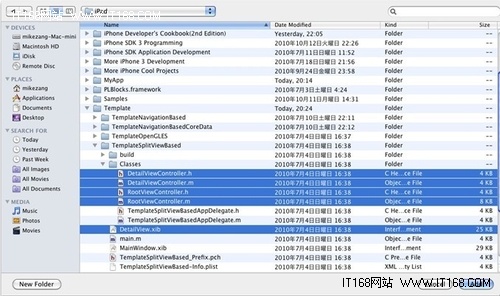
第五步:在SplitInTabBarAppDelegate.h中加入下面的代码:
@class RootViewController;
@class DetailViewController;
@interface SplitInTabBarAppDelegate : NSObject {
UIWindow *window;
UITabBarController *tabBarController;
UISplitViewController *splitViewController;
RootViewController *rootViewController;
DetailViewController *detailViewController;
}
@property (nonatomic, retain) IBOutlet UIWindow *window;
@property (nonatomic, retain) IBOutlet UITabBarController *tabBarController;
@property (nonatomic, retain) IBOutlet UISplitViewController *splitViewController;
@property (nonatomic, retain) IBOutlet RootViewController *rootViewController;
@property (nonatomic, retain) IBOutlet DetailViewController *detailViewController;
@end
第六步:在SplitInTabBarAppDelegate.m中加入下面的代码
#import "SplitInTabBarAppDelegate.h"
#import "RootViewController.h"
#import "DetailViewController.h"
@implementation SplitInTabBarAppDelegate
@synthesize window;
@synthesize tabBarController;
@synthesize splitViewController;
@synthesize rootViewController;
@synthesize detailViewController;
#pragma mark -
#pragma mark Application lifecycle
-(void) makeSplitViewController {
NSMutableArray *controllers = [NSMutableArray arrayWithArray:tabBarController.viewControllers];
int index = 0;
for (UIViewController *controller in tabBarController.viewControllers) {
if (index == 2) {
detailViewController = [[DetailViewController alloc] initWithNibName:@"DetailView" bundle:nil];
rootViewController = [[RootViewController alloc] initWithStyle:UITableViewStylePlain];
rootViewController.detailViewController = detailViewController;
rootViewController.navigationItem.title = @"List";
UINavigationController *nav = [[[UINavigationController alloc] initWithRootViewController:rootViewController] autorelease];
splitViewController = [[UISplitViewController alloc] init];
splitViewController.tabBarItem = controller.tabBarItem;
splitViewController.viewControllers = [NSArray arrayWithObjects:nav, detailViewController, nil];
splitViewController.delegate = detailViewController;
[controllers replaceObjectAtIndex:index withObject:splitViewController];
}
index++;
}
tabBarController.viewControllers = controllers;
}
- (BOOL)application:(UIApplication *)application didFinishLaunchingWithOptions:(NSDictionary *)launchOptions {
// Override point for customization after app launch.
[self makeSplitViewController];
// Add the tab bar controller's current view as a subview of the window
[window addSubview:tabBarController.view];
[window makeKeyAndVisible];
return YES;
}
- (void)splitViewController: (UISplitViewController*)svc willHideViewController:(UIViewController *)aViewController withBarButtonItem:(UIBarButtonItem*)barButtonItem forPopoverController: (UIPopoverController*)pc {
UIBarButtonItem *first = nil;
if (toolbar.items.count > 0) {
first = [toolbar.items objectAtIndex:0];
}
if (![first.title isEqual:barButtonItem.title]) {
barButtonItem.title = @"Root List";
NSMutableArray *items = [[toolbar items] mutableCopy];
[items insertObject:barButtonItem atIndex:0];
[toolbar setItems:items animated:YES];
[items release];
self.popoverController = pc;
}
}
第七步:现在编译第二步的项目就会看到下面的结果。
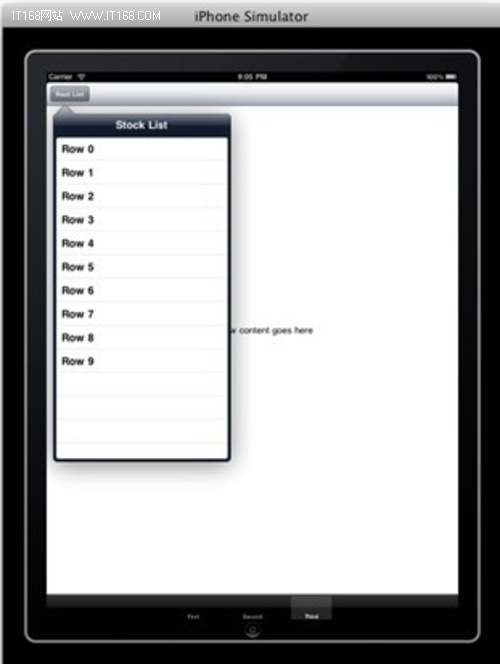
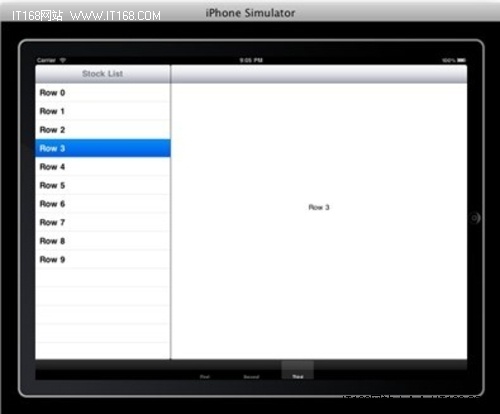



【推荐】国内首个AI IDE,深度理解中文开发场景,立即下载体验Trae
【推荐】编程新体验,更懂你的AI,立即体验豆包MarsCode编程助手
【推荐】抖音旗下AI助手豆包,你的智能百科全书,全免费不限次数
【推荐】轻量又高性能的 SSH 工具 IShell:AI 加持,快人一步
· 如何编写易于单元测试的代码
· 10年+ .NET Coder 心语,封装的思维:从隐藏、稳定开始理解其本质意义
· .NET Core 中如何实现缓存的预热?
· 从 HTTP 原因短语缺失研究 HTTP/2 和 HTTP/3 的设计差异
· AI与.NET技术实操系列:向量存储与相似性搜索在 .NET 中的实现
· 地球OL攻略 —— 某应届生求职总结
· 周边上新:园子的第一款马克杯温暖上架
· Open-Sora 2.0 重磅开源!
· 提示词工程——AI应用必不可少的技术
· .NET周刊【3月第1期 2025-03-02】
2012-01-05 iPhone的解锁、越狱、激活、固件等等是什么意思,有什么分别?(转)
2012-01-05 iOS Programming – 触摸事件处理 (转)
2012-01-05 英语单词学习
2012-01-05 objective-c与java的几点不同 (转)
2012-01-05 慎用ViewController的跳转 (转)
2012-01-05 NSArray,NSSet,NSDictionary总结 (转)